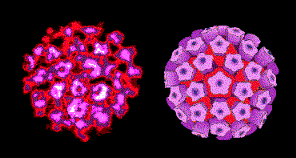
Electron microscope image of HPV particles
The papillomaviruses are a group of
small DNA viruses that infect higher vertebrates; for example, humans,
nonhuman primates, cattle, and deer. These viruses are widespread
in nature and appear to have evolved alongside animals that they
infect.
About 70 different types of virus comprise
the human papillomaviruses (HPVs). These viruses are classified
by scientists as similar or different (from one another) based upon
the genetic sequence that encodes three key viral structures; the
E6, E7 and L1 proteins. All of the human papillomaviruses target
the cells that make up the outer skin, and smooth moist tissues
and mucous membrane surfaces of the body, i.e., the epithelium.
Most HPVs cause small warts or "papillomas"
on the skin surfaces. Some warts may be highly noticeable, resembling
tiny cauliflower that rise above the skin surfaces and rest on very
small stalk-like structures. However, many warts may be flat or
dome-shaped and hardly noticeable to the untrained eye.
 Crystallographic structure of HPV capsid (left) and
computer-generated model
Crystallographic structure of HPV capsid (left) and
computer-generated model The virus particle (virion) itself
is small by virus standards (55 nanometers), and it is not enveloped
by an outer membrane coating. Two virus proteins form the outer
protein coat or capsid, the L1 and L2 proteins, which arrange to
form an icosahedron (i.e., 20 sided shape). The viral DNA is double-stranded,
and exists as a circular and tightly coiled structure contained
within the capsid.
The virion infects a cell by binding
to a receptor on the cell membrane, which triggers the cell to engulf
the virus. The virus particle appears to travel to the cell’s
nucleus and "uncoats" itself to begin manufacturing virus
proteins. The "gene products" or proteins that are made
in the host-cell nucleus from the virus DNA have specific tasks,
some of which we understand and others that remain a mystery. The
early made proteins E6 and E7 have been shown to directly disrupt
normal cell pathways to instead promote virus growth, resulting
in abnormal or even cancerous cells.
Unlike many other viruses, the HPV
life cycle is poorly understood because the virus cannot be readily
grown in the laboratory. Current research focuses on interactions
of the various HPV proteins with host cell machinery, as well as
the mechanisms of immune response to viral proteins. The key to
developing successful treatment lies in better understanding the
protective role of the immune system, as well as unraveling the
complex HPV life cycle so as to effectively disrupt it.